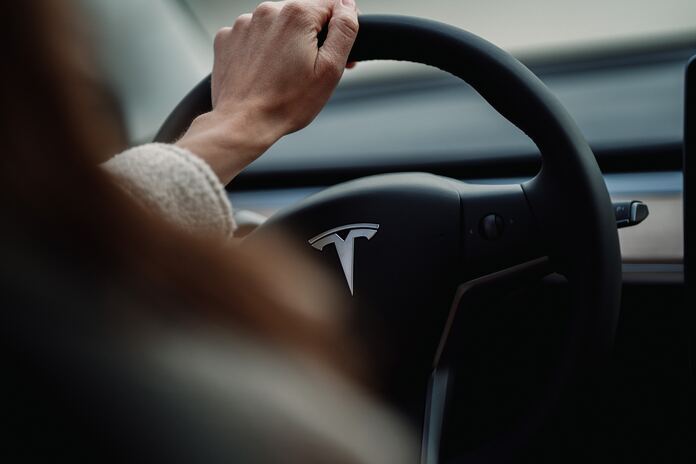Tesla Stock (NASDAQ:TSLA)
Even Tesla, the most valued automaker in the world, suffers from price wars. The greatest detrimental impact on investors: Tesla stock price fell on Thursday.
Despite having poor first-quarter automotive gross profit margins, Tesla’s (NASDAQ:TSLA) first-quarter earnings on Wednesday evening matched expectations. No matter how the figures are sliced and diced, the findings will raise concerns among investors over EV demand and Tesla’s pricing policy.
At $165.06 in lunchtime trade on Thursday, Tesla stock fell 8.6%. The S&P 500SPX -0.60% and Nasdaq Composite are both down roughly 0.4%.
Automotive gross profit margins, excluding regulatory credits, decreased from over 21% in the fourth quarter of 2022 to about 16% this quarter. Since the second quarter of 2020, that number has not been below 20%.
With leases included, the car industry produced gross profit margins of approximately 19%, below Wall Street projections of 21% and below the minimal level of 20% investors were seeking.
It might be challenging to determine the precise size of the miss because some analysts forecast margins without taking into account credits and leasing. The 19% figure is most similar to the 21% that experts and investors were hoping to see.
The main factor for the margin reduction is pricing. Auto sales plus lease revenue divided by delivery yields a proxy for the average price per car sold which was roughly $47,200, down from about $54,400 in the first quarter of 2022.
And the gross profit margin, which includes leasing, was around $8,600 per vehicle sold. That amount was approximately $15,700 a year ago.
It’s not a good showing for the EV manufacturer. Results were considered unsatisfactory by Jesse Cohen, an analyst for Investing.com. In light of Q1 earnings, he stated, “We have less faith in Tesla’s ability to quicken revenue growth and increase operating margin.
In a post-earnings analysis, Canaccord analyst George Gianarikas noted that Tesla is not exempt from headwinds in the larger economy. The pricing reductions by the firm “combined with the recent deterioration in EV-related commodities, indicate to us a weak environment for autos/EVs globally,” the analyst stated. “Tesla is not the problem here. The issue here is one of total auto/EV demand.
The remaining quarter appeared to be fine. On sales of $23.33 billion, which were slightly below estimates of $23.67 billion, Tesla posted a profit of 85 cents per share, beating expectations.
Tesla’s secondary venture performed admirably, bringing in a record $303 million in gross profit. In the quarter, Tesla installed 3.9-gigawatt hours of battery storage, a 300% increase over the same period last year.
Wall Street Estimate
Wall Street had anticipated $3 billion in operational profit, but the actual figure was $2.7 billion. Operating profit margins decreased from 19.2% in the prior quarter to 11.4% this quarter. Operating profit margins, before stock-based compensation, were roughly 13.2%. Tom Narayan, an analyst with RBC, anticipated margins excluding stock-based comp to be around 15.3%.
However, stock-based compensation is still a cost, and Tesla’s 11% operating profit margins make them appear to be more like a conventional automaker. The operating profit margin for Toyota Motor during the fourth quarter was almost 10%.
According to the quarterly report, “We view this year as a unique opportunity for Tesla in the current macroeconomic environment.” “We aim to leverage our position as a cost leader as many automakers struggle with the unit economics of their EV programs,” the company said.
Tesla seems to be using vehicle prices as a weapon to slit the necks of rival companies. Tesla’s challenge is that established automakers General Motors (NYSE:GM) and Ford Motor (NYSE:F) continues to generate significant profits. Losses in other companies’ EV businesses have yet to fully be felt, so Tesla may be taking advantage of its cost advantage early.
On the company’s results conference call on Wednesday night, CEO Elon Musk discussed price. He added that he is allowing other EVs access to the Tesla supercharging network since he didn’t want to eliminate any EV competition.
Overall, Musk didn’t seem very concerned about the margins for one quarter. He wanted to get the most cars onto the market as quickly as possible and was more concerned with autonomic vehicles. When there are more Tesla cars on the road, Tesla can make more money by selling all of them autonomous driving software. At least, that is the plan.
The day of fully automated driving is still far off. In the near future, Musk emphasized that Tesla takes into account growing loan rates as a factor in vehicle affordability.
On the company’s fourth-quarter call in January, CFO Zachary Kirkhorn stated that Tesla might achieve automotive gross profit margins of 20% for the entire year. On Wednesday, he didn’t specifically back down from that position and talked about future cost savings that could be achieved by more effectively leveraging Tesla’s new factories. He did note that ignoring regulatory credits, recent price reductions “lower the floor” for automotive gross profit margins.
Demand trends are interesting to investors as well. Orders still outpace supply, according to Musk.
According to production estimates, Musk continued, “We feel comfortable with 1.8 [million] vehicles this year.”
For 2023, Wall Street anticipates 1.8 million deliveries. Investors can take solace in Musk’s remarks.
Costs are decreasing, which is another plus. In the second quarter of 2022, when it peaked at nearly $42,700, the average cost to construct a car was about $38,600. Investors should only use the cost calculation as a general guide because the type of vehicle bought affects both pricing and cost calculations.
The non-automotive sector was also advantageous. Without leasing, gross profit margins were roughly 8%, up about 10% from the previous year. William Stein, a Truist analyst, noted that service revenue was at an all-time high of $1.8 billion.
Bulls will find some comfort in the good news. But for the time being, Tesla is primarily a car company. Selling vehicles and leasing cars account for more than 90% of total revenue.
Featured Image: Unsplash @ Jenny Ueberberg















